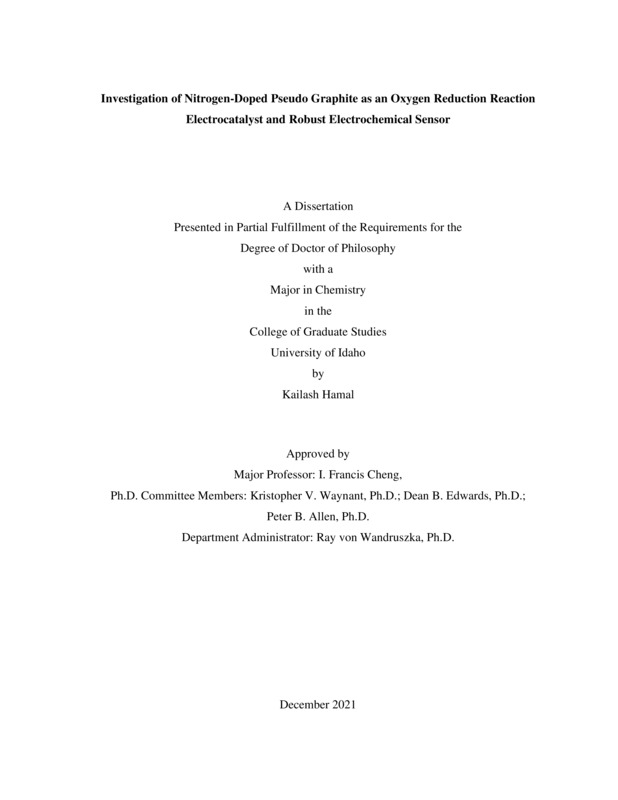Investigation of Nitrogen-Doped Pseudo Graphite as an Oxygen Reduction Reaction Electrocatalyst and Robust Electrochemical Sensor
Hamal, Kailash. (2021-12). Investigation of Nitrogen-Doped Pseudo Graphite as an Oxygen Reduction Reaction Electrocatalyst and Robust Electrochemical Sensor. Theses and Dissertations Collection, University of Idaho Library Digital Collections. https://www.lib.uidaho.edu/digital/etd/items/hamal_idaho_0089e_12269.html
- Title:
- Investigation of Nitrogen-Doped Pseudo Graphite as an Oxygen Reduction Reaction Electrocatalyst and Robust Electrochemical Sensor
- Author:
- Hamal, Kailash
- Date:
- 2021-12
- Embargo Remove Date:
- 2022-12-21
- Program:
- Chemistry
- Subject Category:
- Chemistry
- Abstract:
-
This dissertation discusses the nitrogen modification of GUITAR (Pseudo-Graphite from the University of Idaho Thermalized Asphalt Reaction). Different methods for selectively doping a variety of nitrogen moieties and their characterization are presented in various chapters. Chapter one introduces the material ‘GUITAR’ and presents the motivation for these works. Chapter two discusses the method for selectively doping pyridinic- and pyrrolic-nitrogen groups (with 0.0 % graphitic nitrogen) onto the GUITAR surface. It is herein referred to as N’-GUITAR. Physical and electrochemical characterization revealed that this material makes the robust electrode for oxygen reduction reaction (ORR) via four-electron pathways, which is desirable for fuel cell applications. The material exhibited high performance and excellent stability than any other carbon materials reported in the literature. Chapter three presents the method for synthesis of N-GUITAR, which comprises predominantly graphitic nitrogen(72.6%). Like N’-GUITAR, this material retains basic characteristic features of GUITAR but demonstrated robustness toward electrode fouling by air aging and polymerization of matrix components during dopamine detection. Application of later form of selectively nitrogen-doped GUITAR (N-GUITAR) for ORR is discussed in chapter four. This material efficiently reduces oxygen to hydrogen peroxide via two-electron pathways. It exhibited higher current efficiency (up to 96%) for H2O2 generation with a significant production rate. This experimental result, along with the results from chapter two, suggests that graphitic nitrogen moieties are responsible for two-electron ORR to hydrogen peroxide. In contrast, pyridinicand pyrrolic- nitrogen moieties are responsible for four-electron ORR to water. The ability to selectively dope different nitrogen moieties is unique to this GUITAR material. This investigation, along with the resistance behavior of the N-GUITAR electrode, is summarized in chapter five. Chapter five further reveals the possibilities of this material as an excellent electrocatalyst and robust electrochemical sensor for numerous applications.
- Description:
- doctoral, Ph.D., Chemistry -- University of Idaho - College of Graduate Studies, 2021-12
- Major Professor:
- Cheng, I. Francis
- Committee:
- Waynant, Kristopher; Edwards, Dean; Allen, Peter; von Wandruszka, Ray
- Defense Date:
- 2021-12
- Identifier:
- Hamal_idaho_0089E_12269
- Type:
- Text
- Format Original:
- Format:
- application/pdf
- Rights:
- In Copyright - Educational Use Permitted. For more information, please contact University of Idaho Library Special Collections and Archives Department at libspec@uidaho.edu.
- Standardized Rights:
- http://rightsstatements.org/vocab/InC-EDU/1.0/

